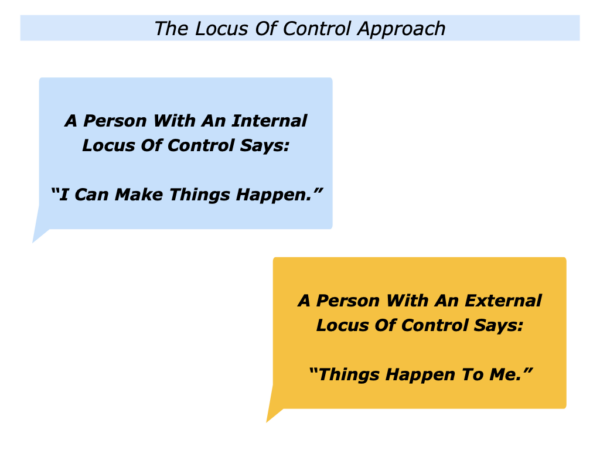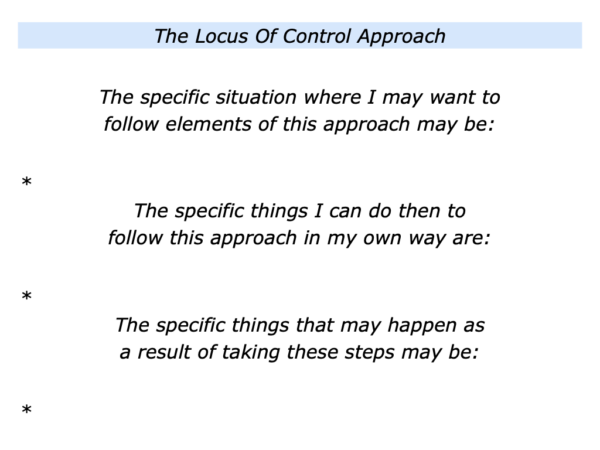
Imagine you are helping a person to shape their future. Whichever approach you use, at some point you will probably invite the person to take responsibility for working towards their goals.
This calls for them strengthening their internal locus of control – a term coined by Julian Rotter in the 1950s. Let’s explore what this means.
A person with an
internal locus of control
They believe they can make things happen and help to shape their future;
They believe that, whilst external events may bring challenges, they can take an internal decision regarding how they respond to such events;
They say things like: “I can take responsibility … I can make things happen … I can recover from setbacks.”
A person with an
external locus of control
They believe they have little control over their lives and shaping their future;
They believe they are at the mercy of events and these determine their happiness;
They say things like: “The world is against me … Why do things like this always happen to me? … Everything would be okay if I won the lottery.”
Many individuals reach a point where they develop their internal locus of control. They then aim to shape their future.
Some people prefer to blame outside circumstances. Others may try to help them, but their suggestions fall on unreceptive ground. They are met by the person saying:
“Yes, but …”
A person must develop the will before they can learn a skill. Let’s explore how you may be able to encourage them to take this step. Whether they want to do this will, of course, be up to them.
Helping a person to develop
their internal locus of control
Let’s return to a situation where a person has asked for your help. They may be facing a challenge, aiming to overcome a tragedy or wanting to improve their performance.
Whichever approach you use it will involve the person taking responsibility. It will call for them saying: “I can …” rather than “I can’t …”
How can you help them to take this step? You can do your best but it will ultimately be up to the person to demonstrate they are prepared to take charge of shaping their future.
There are many things you can do, however, to give them the opportunity to take this step. Let’s look at some of the approaches you can take.
The Picture Of Success Approach
This approach involves creating a positive environment in which a person feels at ease. Bearing in mind the topic they want to explore, it then involves doing three things.
First, to encourage the person to raise their sights and focus on shaping their future. Second, to clarify their picture of success. Third, to clarify the benefits of achieving this picture of success.
Imagine you are helping a person to take these steps. You will do this in your own way, but here are some of the questions you may want to explore with the person.
“Bearing in mind the things you can control in the situation, what would like to happen in the future? What are the real results you want to achieve? What is your picture of success?
“What would be the benefits of achieving these goals? On a scale 0-10, how motivated are you to work towards achieving them?”
People are often motivated by benefits. It can therefore be useful to help a person to focus on what they may gain by achieving certain goals. It then up to them to decide if they want to do the work involved.
The Personal Strengths Approach
This approach involves helping a person to build on their strengths when working to achieve their goals. There are many ways to help them to take this step. One model is to help them to learn from their positive history.
Everybody has a positive history. They have a history of managing challenges or achieving goals successfully. Bearing in mind the topic they want to tackle, it can be useful to invite them to explore the following questions.
“Looking back, when have you tackled a similar challenge or achieved a similar goal successfully? What did you do right then? What were the principles you followed? How did you translate these into action?
“How can you follow similar principles in this situation? How can you translate these into action? What other skills may you need to add? How can you then do your best to achieve the picture of success?”
This approach can help a person to develop belief in their gut and follow their successful pattern. If they have done it before, they can do it again.
The Practical Strategies
That Work Approach
Imagine that you are helping a person to explore ways they can reach their goals. One approach is to learn from good educators. Such people sometimes aim:
To study what works;
To simplify what works – but to do this in a profound way;
To share what works.
Bearing in mind the person’s goals, you may have already explored the what may have worked for them in the past. If appropriate, you can share what other people have done to tackle such challenges successful. This can add to a person’s repertoire for shaping their future.
One key point. This does involve you having studied what has worked for people in similar situations. If appropriate, you may then say something along the following lines to the person.
“We have already explored how you can learn from your own successes. Sometimes it can be useful to learn from how other people have succeeded.
“Is it okay to for me share some ideas about how other people have tackled this kind of issue successfully? If appropriate, you can then follow some of these principles in your own way.
“Looking at the goals you want to achieve, here are some strategies that seem to work in this kind of situation.
“One strategy is to …
“Another strategy is to …
“Another strategy is to …
“We know that doing some of these things can work. But it is up to you, of course, to decide if you want to apply any of these ideas in your own way.”
There are many ways to help a person to strengthen their inner locus of control. These can include helping them:
To clarify their picture of success … To build on their personal strengths … To share practical strategies that work.
Whichever approach is used, however, it is up to the person to decide if they want to shape their future. You can only do your best to increase their options for making this happen.
Let’s return to your own life and work. Looking ahead, can you think of a specific situation where you may want to follow elements of the locus of control approach? How can you do this in your own way?
If you wish, try tackling the exercise on this theme. This invites you to complete the following sentences.

A person with an
external locus of control






Leave a Reply